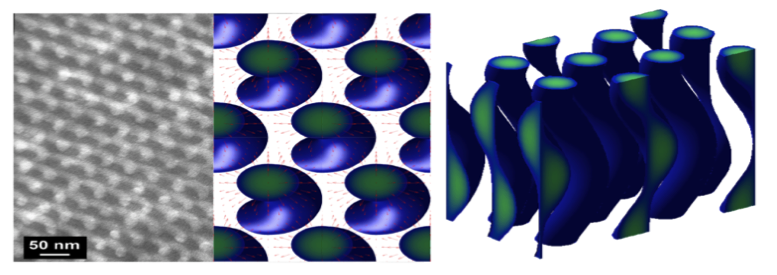 Supermolecular, helical assemblies are a common structural motif
Supermolecular, helical assemblies are a common structural motif
exploited in far-ranging biological contexts, from the flagellar appendages of
swimming microorganisms to the protein coats that sheath rod-like viruses. The screw-like structure of these
biological assemblies is a consequence of the chiral subunits (proteins and amino acids) from which they are
built, and this chirality imbues the
structures with a right- or left-handed sense or twist. Grason and Russell, working
collaboratively at the Materials Research Science and Engineering Center at
UMass Amherst, demonstrate that a similar strategy may be employed in synthetic
polymers, which are seen to self-assemble into helical structures. In general, block copolymers are
assemble into array of mirror-symmetric, nano-structured
arrays of ordered spherical, cylindrical and layered domains. This work uncovered a novel theoretical
tool to both model and predict the self-assembled structures that emanate from
constructing one of the constituent polymeric blocks from chiral segments. The theory shows that interactions
between chiral segments “twist” the
trajectories of the self-organized chain molecules. This twist is transmitted through the tension carried along
the chains to the entire assembly, driving otherwise cylindrical assemblies to
“buckle” into nanohelices organized in a
hexagonal array. These results
confirm the notion that mesoscopic, helical structures
observed on tens of nanometer length scales in melts of the chiral block copolymer,
poly-L-lactide-b-polystyrene, stems from the chiral nature of
inter-molecular forces taking place at the nanometer lengthscale. Going forward, this opens a door to a
new class of complex meso-chiral structures formed in
chiral block copolymer
materials yet to be discovered.